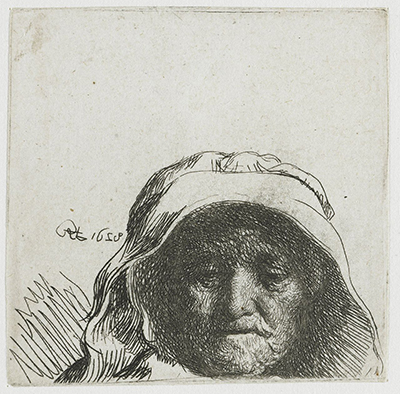Rembrandt's mother would appear in a number of his artworks, across a variety of mediums. In this case we find her portrait within a powerful etching in which she is hooded and looking down in a thoughtful manner.
This particular artwork would become known as The Artist's Mother, Head only, Full Face, and fairly descriptive titles were given to many of Rembrandt's work by art historians in order to allow us to better identify specific pieces within such a huge output of work across his lifetime. The artist would use the medium of etching as a means to earning more money from his work, thanks to the printing process which enabled him to create copies of his designs and sell these on at highly competitive prices. There were specialists in this process whose services Rembrandt could call upon in order to make the final prints as professional and accurate to the original design as possible.
The precise techniques used by Rembrandt were never documented in any great detail, as the artist liked to keep a certain level of secrecy around his work in this medium. He did consult and work with printing specialists in order to better understand the techniques involved, but once he had established himself, he was less willing to be as open anymore. We do know that he used the printing process also a means of testing his designs, with it allowing him to continually tweak artworks and then release further series of prints. He was something of a perfectionist in this regard, and enjoyed the flexibility given to him when working with etchings. He even kept information on his process away from his closest and most respected assistants.
This etching was printed in 1628, as signed on the front and written in notes on the back as well. One copy from this series is now owned by the V&A Museum in London which itself holds a substantial catalogue of old masters prints such as this. They have described it as from the second state, which means there was probably one earlier set of prints produced before several changes were then made for this one. It is also listed as a bequest from someone called C.A. Ionides and many of the major art institutions have built up collections based on generous donations in this way.




